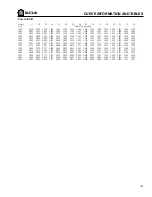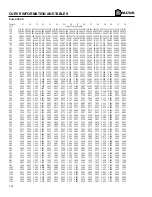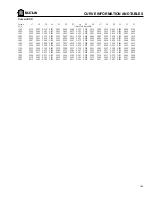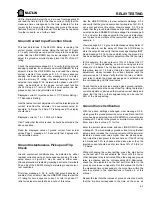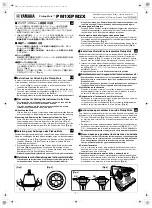
RELAY TESTING
8-1
Primary Injection Testing
Complete system operation can be checked by injecting
current through the phase and ground CT’s, and by providing
a potential source. To do this a primary (high current) test set
is required. The operation of the entire system including CT’s
can then be checked. If this equipment is not available,
secondary injection tests can be done to check everything
except the CT’s. This procedure is described in the following
sections.
Secondary Injection Testing
Single phase secondary injection testing can be performed
using the test setup in Figure 8.1. The tests described here
apply to the relay with factory setpoints unchanged. Similar
tests can be performed when new setpoints have been
stored. Make a note of any setpoints changed so that these
can be returned to their original values. To avoid unneces-
sary breaker tripping and alarms it is recommended that
related connections be removed during these tests.
If a trip has been assigned to another relay instead of the trip
relay, then the latching relay in Figure 8.1, should be con-
nected to this relay’s contacts for the tests. Refer to sections
5 & 6 of this manual to locate the messages referred to in
these test procedures. Note that these tests cannot be
performed unless the correct access code is entered in page
1 of setpoints and the access jumper or keyswitch is closed.
When values are stored, by pressing the STORE key, verify
that the NEW SETPOINT STORED message appears.
Phase Current Input Function Check
The 565/575 Relay must read the phase current signals from
the CT’s correctly to provide the instantaneous and timed
overcurrent protection. To determine if the 565/575 Relay is
reading the correct current values with the test setup in
Figure 8.1, apply control power, change the phase overcur-
rent pickup level to 100% of the CT primar y in page 2 of
setpoints, and put the 565/575 Relay into actual values
mode. Use the test set current adjustment to set the phase
current injected into the phases, to a mid value, which is read
from the ammeter. This can be 2 Amps if a 5 Amp CT is being
used or 0.4 Amps if a 1 Amp CT is being used.
Read the displayed value of current for the selected phase
from actual values Page 1, message A 1.2, 1.3, or 1.4. With
the factory setpoints the CT ratio will be set at 100/5. Verify
that the displayed current is:
Displayed current = Injected current × CT Primary Rating ö
CT Secondary Rating
For example, if 5 Amp CT’s are being used, and the ammeter
reading has been adjusted to 2 Amps, the display should
read:
Displayed current = 2 × 100/5 or 40 Amps.
If a CT ratio other than this is used, it should be entered in the
above equation. Turn the phase current off.
Phase Instantaneous Pickup and Trip
Check
Test phase A instantaneous overcurrent pickup as follows:
Press the SETPOINTS key to enter setpoints mode and the
PAGE key to view page 2. Using the LINE DOWN key read
the phase CT primary rating from message S 2.2 and verify
that the phase instantaneous trips are enabled by viewing
message S 2.11. If not, select enabled using the NEXT
CHOICE key and store the value. Use the LINE UP key to
view message S 2.3 and set the Phase overcurrent pickup
level to 25%. View message S 2.12 and enter a value for the
phase instantaneous overcurrent trip level, as a multiple of
the overcurrent pickup level, for example, 3.
Set the phase instantaneous trip time delay to instantaneous
as follows:
Use the LINE DOWN key to view message S 2.13, phase
instantaneous trip delay. Enter 0 for this setpoint. Press
STORE to store the setpoint in the 565/575 Memory. Verify
that INST is displayed by message S 2.13.
Using the test setup variac, slowly increase the phase cur-
rent injected until the trip or other assigned relay is activated
and the corresponding LED is illuminated. Verify that the
injected current at the time of trip corresponds to the instan-
taneous pickup value entered in the setpoints message S
2.12, ±5%. In this case, the pickup level was set at 25% of the
CT secondary rating, (5 Amps) or 1.25 Amps. The trip level is
three times this or 3.75 Amps.
Check that the actual values page 5 message gives Phase A
instantaneous overcurrent, as the cause of last trip. Slowly
decrease the phase current and check that the trip relay can
be reset at or below 95% of the pickup level.
Phase Overcurrent Curve Verification
With factory settings view setpoints message S 2.4. This
gives the curve shape currently in use for the overcurrent
protection. Note which curve has been selected.
View message S 2.3, which gives the phase overcurrent
pickup level. Use the LINE DOWN key to view message S
2.5, which is the phase overcurrent curve number. Enter and
store a value of 1 for this. Using the test setup current
adjustment, set the phase current to the trip level and turn
off. In this example, this was three times the pickup, or 3.75
Amps as described above. Without changing the current
setting, press the test set start button, to activate the timer.
Check the time elapsed when the trip or other assigned relay
Summary of Contents for 565
Page 6: ...INSTALLATION 2 2 Figure 2 1 Mounting Details ...
Page 7: ...INSTALLATION 2 3 Figure 2 2 Mounting Arrangement with Relay Collar ...
Page 12: ...INSTALLATION 2 8 Figure 2 5 565 Relay Typical Wiring ...
Page 13: ...INSTALLATION 2 9 Figure 2 6 Voltage Sensing Wire ...
Page 14: ...INSTALLATION 2 10 Figure 2 7A 565 with MTM CT and Open Delta VT Typical Wiring ...
Page 15: ...INSTALLATION 2 11 Figure 2 7B 565 with MTM CT and Wye VT Typical Wiring ...
Page 16: ...INSTALLATION 2 12 Figure 2 8A Open Delta VT and CT MTM Typical Wiring ...
Page 17: ...INSTALLATION 2 13 Figure 2 8B Wye VT and CT MTM Typical Wiring ...
Page 18: ...INSTALLATION 2 14 Figure 2 9 MTM Mounting Dimensions ...
Page 19: ...INSTALLATION 2 15 Figure 2 10 565 Rear Panel Layout ...
Page 20: ......
Page 23: ...DISPLAY AND KEYBOARD 3 3 Figure 4 1 565 Relay Front Panel ...
Page 28: ......
Page 132: ......
Page 142: ...CURVE INFORMATION ANDTABLES 7 10 Figure 7 9 IEC A Curves ...
Page 143: ...CURVE INFORMATION ANDTABLES 7 11 Figure 7 10 IEC B Curves ...
Page 144: ...CURVE INFORMATION ANDTABLES 7 12 Figure 7 11 IEC C Curves ...
Page 176: ...RELAYTESTING 8 2 Figure 8 1 Secondary Injection Test Setup ...
Page 180: ......
Page 184: ......
Page 192: ...APPENDIX C C 2 Figure C1 System Controller Block Diagram 1 2 ...
Page 193: ...APPENDIX C C 3 Figure C2 System Controller Block Diagram 2 2 ...
Page 194: ......
Page 198: ......










